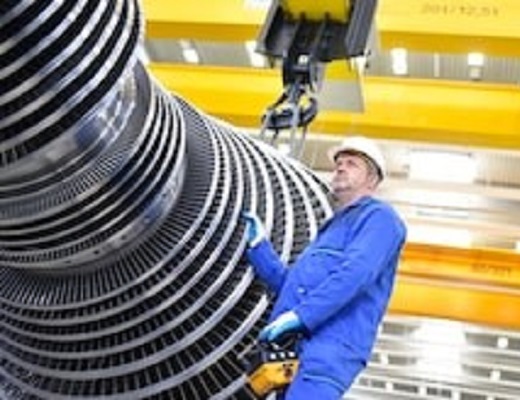Gas turbines are one of the most widely used power generation technologies today. A gas turbine is an internal combustion engine (IC) that creates high-temperature gas by burning a mixture of fuel and air and rotating the turbine to generate electricity. The name of the gas turbine is not the fuel itself, but the heat that is generated when the fuel is burned. Gas turbines can use a variety of fuels, including natural gas, heating oil, and synthetic fuels. In contrast to reciprocating internal combustion engines, in which combustion takes place intermittently, combustion in gas turbines takes place continuously.
How a Gas Turbine Works
The thermodynamic process used in gas turbines is the Brayton cycle (except for the fourth step). Air and fuel are the two main components needed to run a gas turbine. The fuel is usually natural gas, but other liquid fuels are also used. Air is first drawn in from one end of the turbine and passed through the compressor section.

When it is compressed, the temperature of the air rises and so does the pressure. Next, fuel is injected into the turbine. Here it mixes with compressed air and starts to burn. That’s chemical energy. The ratio of air to gas depends on many factors, such as the specific calorific value of the gas, the water content and the air quality.
The hot gas generated by the ignited fuel-air mixture comes into contact with the turbine blades and causes them to rotate at very high speeds (approx. 3,200 rpm). Therefore, chemical energy is converted into mechanical energy. This usually happens with jet engines.
Gas turbines are also widely used to generate electricity. They are an integral part of a combined cycle power plant, in which chemical energy is converted into mechanical energy and this mechanical energy is then converted into electrical energy. As mentioned above, the high temperature and high-pressure gas causes the blade to rotate at high speed. This rotates the drive shaft. Then the rotational energy is transferred to the generator shaft (motor) via the gearbox.
The generator has a large magnet surrounded by a coil of copper wire. When a magnet starts rotating at high speed, it creates a strong magnetic field that moves electrons and creates electricity. The excess energy generated by the turbine can be used to generate steam and operate the steam turbine. Therefore, the simultaneous use of a steam turbine and a gas turbine enables more efficient power generation.
ADVANTAGES GAS TURBINE POWER PLANT
- The operational speed of these turbines is high.
- The gas power plants are environmentally friendly.
- They require less space for installation.
- The gas power plants have a lower cost than other plants.
- The gas turbine has very high mechanical efficiency.
- They have very high reliability.
- These are flexible turbines.
- They need less maintenance.
DISADVANTAGES OF GAS TURBINE
- The service life of the gas turbines is lower than other turbines.
- The gas power plants require a special cooling system for cooling purposes.
- This plant has complicated design than diesel plants.